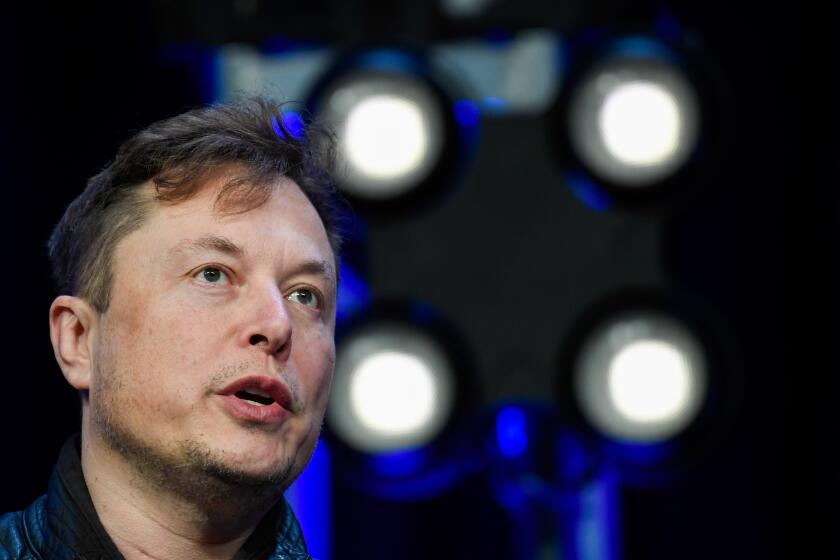Pulling the plug on a dream
- Share via
IT was reported last week that General Motors Corp. is developing a hybrid-electric car with a battery that could be recharged at any outlet.
With soaring gas prices and increasingly dire news about global warming -- including the Al Gore documentary “An Inconvenient Truth” -- GM’s plans could be seen as a step in the right direction.
Ironically, however, it was General Motors that produced the first modern electric car back in 1996 -- the EV1. Then it quite literally took the cars out of the hands of drivers and destroyed the vehicles.
“Who Killed the Electric Car?,” a documentary that opened Wednesday, examines the short life and death of the EV1 and why GM crushed the fleet in the Arizona desert.
“I didn’t start off thinking I was making a conspiracy movie,” says director Chris Paine, who leased an EV1 from 1997 to 2003. “We kept waiting for major media outlets to do the story.”
It’s a complicated story -- sort of a vehicular version of “Murder on the Orient Express” -- with the auto manufacturers, the government, the oil companies and consumers all sharing blame in the demise of the EV1.
Sixteen years ago, the California Air Resources Board realized that the pollution crisis in the state had reached epidemic proportions and smog threatened the public’s health. To rein in toxic auto exhausts, the board announced the Zero Emissions Mandate, which required 2% of new vehicles sold in California to be emissions free by 1998 and 10% by 2003.
Though Toyota and Ford also developed electric cars, General Motors’ EV1 was considered the most reliable. It required no gas, no oil changes and no mufflers. The only maintenance needed was on the brakes, tires and windshield-washer fluid. It was fast and modern and could go approximately 100 miles on a charge. The cars leased for $400 to $500 a month.
“I got my EV1 in 1997,” said Paine. “I had to seek it out a little bit and was pretty early to get in line to get one. I had no idea how amazing it was to drive an electric car.”
Eventually, though, the 2,000 or so people who leased the EV1 -- GM didn’t sell the cars -- slowly discovered that their leases weren’t being renewed.
Paine said he lost his car in 2003 after taking it to a dealership to get the wheels checked. When he called to pick it up, he learned it had been returned to GM. Paine was shocked, especially since he had a few months left on his lease.
“They said, ‘We will give you a loaner car and a coupon for another fine Saturn vehicle,’ ” he recalled. “It was very odd. They just wouldn’t tell me where it was.”
Executive producer Dean Devlin (“Independence Day,” “Godzilla”) had a similar experience.
“My father had the first EV1 that was brought to California,” Devlin said. He got his own EV1 in 1998 and lost it in 2003.
“I got a letter saying my lease was up and they expected me to turn the car in,” Devlin explained.
“I called lawyers and said, ‘What would happen if I didn’t turn the car in?’ and ‘Could we fight this?’ I was advised I would be prosecuted for stealing the car! They did an inspection of the car and for every little scratch they charged me. Then they took the car away from me and promptly crushed it.”
“It’s like they were trying to erase history,” Paine said. “Like what happened at the Smithsonian when they took the EV1 out of display the week before our movie opens. They removed it from the General Motors Hall of Transportation. The Smithsonian said they took it out because they are remodeling the museum and it had nothing to do with the movie. But they are replacing it with an SUV!”
The EV1’s fate was sealed in 2000 when GM Vice Chairman Harry Pearce said there was “no particular need” to continue building electric cars.
In 2002, GM, DaimlerChrysler and seven San Joaquin Valley auto dealerships sued the California Air Resources Board in a U.S. District Court in Fresno to repeal the Zero Emissions Mandate.
The following year, the board declared that auto manufactures no longer had to make electric cars. Instead, they were required to produce a mix of fuel cell vehicles, gas-electric hybrids and partial emission vehicles beginning in 2008.
Both Devlin and Paine still drive electric cars -- the Toyota RAV4 EV, which the company stopped producing in 2003, citing poor sales. And they are high on hybrids.
“They are getting people used to the idea of electricity in the car and they are showing the auto company you can make money on these things,” Paine said. “So this is a great steppingstone. But they are still gas cars and we think this is really a trade-off with the gas companies.”
“Our belief is the plug-in hybrid is really the future,” Devlin said.
“Who Killed the Electric Car?” doesn’t lay all the blame for the EV1’s death on GM and the oil companies, Devlin said, because “the truth of the matter of the story is that the car companies made the car because they were forced by a California mandate. The irony is that they made probably the greatest car they ever made -- a car that was so good it actually threatened the status quo. That’s why there were so many suspects in the murder.”







